Wireless Networking Concepts Report - University, Semester 1, 2024
VerifiedAdded on 2020/03/01
|9
|1334
|42
Report
AI Summary
This report delves into the core concepts of wireless networking, providing a detailed analysis of various antenna types, including horn, Yagi, parabolic reflector, and half-wave folded dipole antennas, outlining their working principles, applications, strengths, and weaknesses. The report also explores multiplexing techniques, specifically comparing Code Division Multiple Access (CDMA) and Frequency Division Multiple Access (FDMA), illustrating their differences with diagrams and explanations. Furthermore, the report identifies and evaluates the top four wireless technologies: Wi-Fi, Bluetooth, Voice over Internet Protocol (VoIP), and Worldwide Interoperability for Microwave Access (WiMAX), detailing their applications, advantages, and disadvantages. The report concludes with a comprehensive list of references to support the information presented.
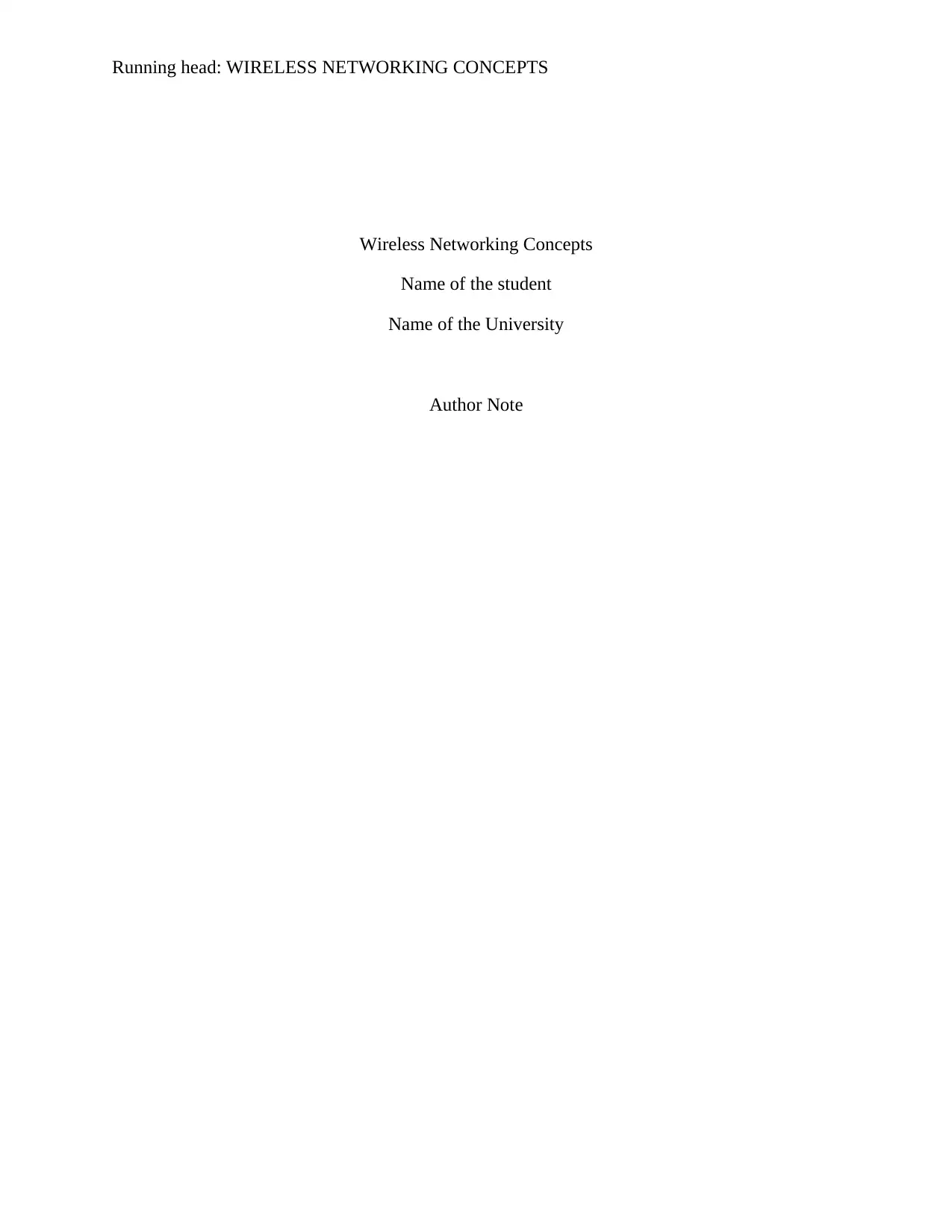
Running head: WIRELESS NETWORKING CONCEPTS
Wireless Networking Concepts
Name of the student
Name of the University
Author Note
Wireless Networking Concepts
Name of the student
Name of the University
Author Note
Paraphrase This Document
Need a fresh take? Get an instant paraphrase of this document with our AI Paraphraser
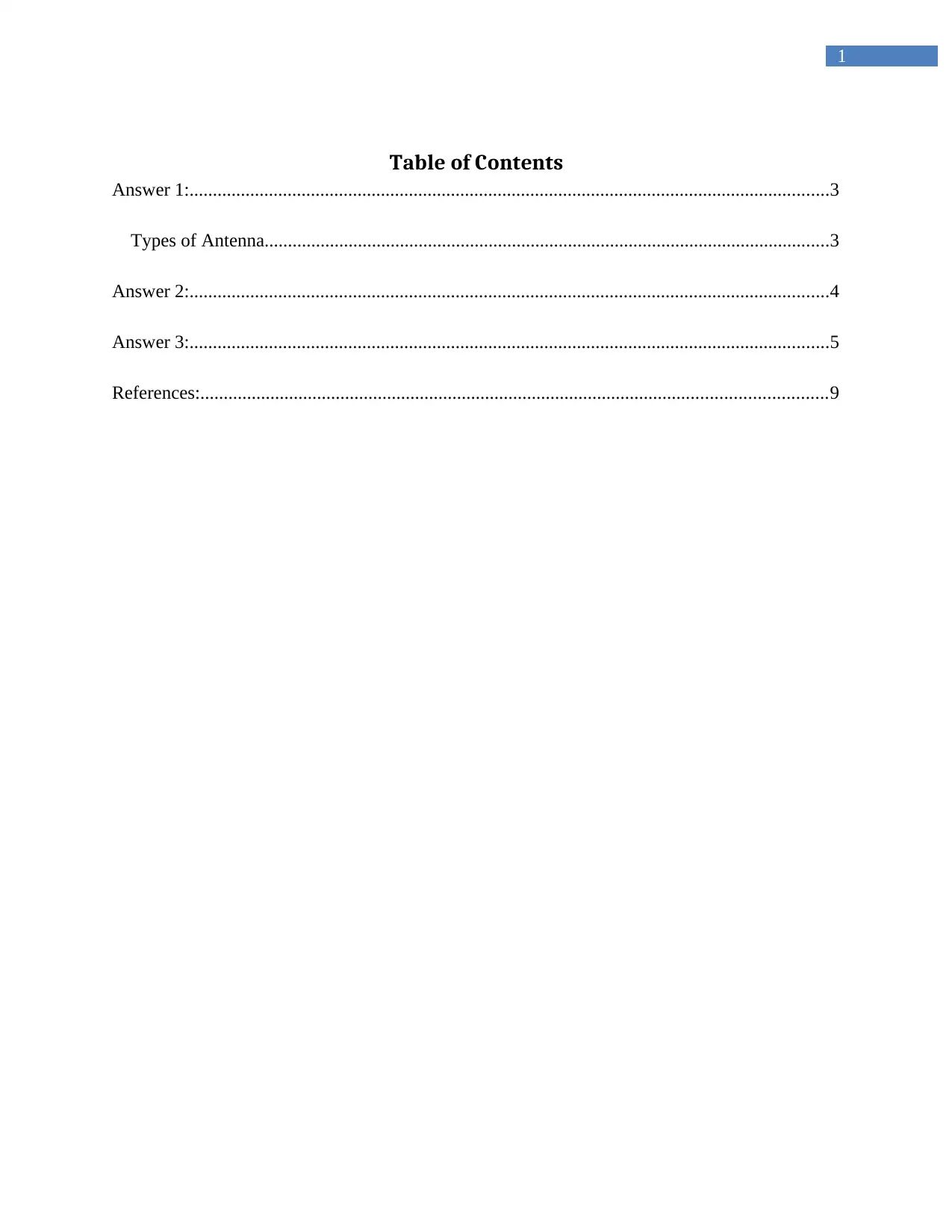
1
Table of Contents
Answer 1:.........................................................................................................................................3
Types of Antenna.........................................................................................................................3
Answer 2:.........................................................................................................................................4
Answer 3:.........................................................................................................................................5
References:......................................................................................................................................9
Table of Contents
Answer 1:.........................................................................................................................................3
Types of Antenna.........................................................................................................................3
Answer 2:.........................................................................................................................................4
Answer 3:.........................................................................................................................................5
References:......................................................................................................................................9
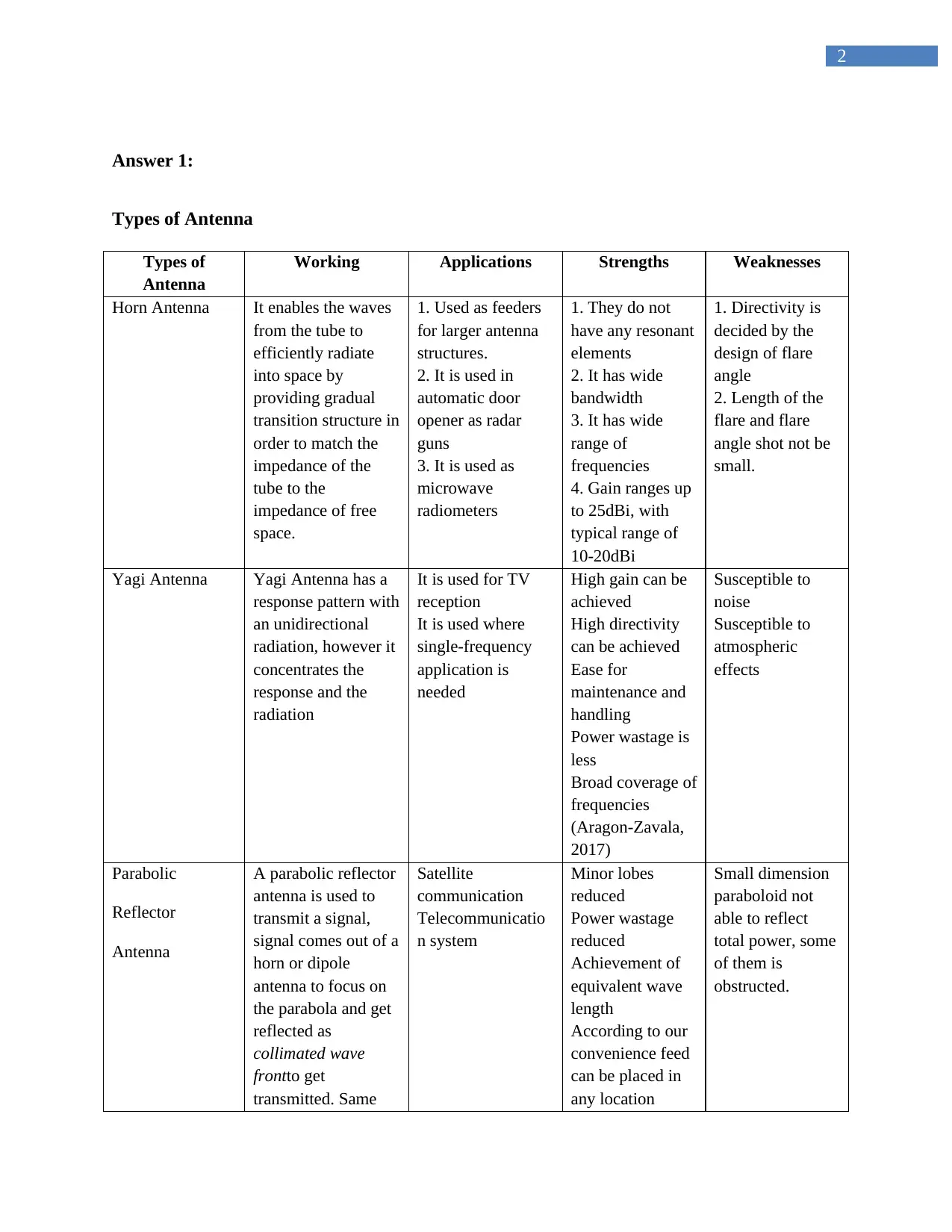
2
Answer 1:
Types of Antenna
Types of
Antenna
Working Applications Strengths Weaknesses
Horn Antenna It enables the waves
from the tube to
efficiently radiate
into space by
providing gradual
transition structure in
order to match the
impedance of the
tube to the
impedance of free
space.
1. Used as feeders
for larger antenna
structures.
2. It is used in
automatic door
opener as radar
guns
3. It is used as
microwave
radiometers
1. They do not
have any resonant
elements
2. It has wide
bandwidth
3. It has wide
range of
frequencies
4. Gain ranges up
to 25dBi, with
typical range of
10-20dBi
1. Directivity is
decided by the
design of flare
angle
2. Length of the
flare and flare
angle shot not be
small.
Yagi Antenna Yagi Antenna has a
response pattern with
an unidirectional
radiation, however it
concentrates the
response and the
radiation
It is used for TV
reception
It is used where
single-frequency
application is
needed
High gain can be
achieved
High directivity
can be achieved
Ease for
maintenance and
handling
Power wastage is
less
Broad coverage of
frequencies
(Aragon-Zavala,
2017)
Susceptible to
noise
Susceptible to
atmospheric
effects
Parabolic
Reflector
Antenna
A parabolic reflector
antenna is used to
transmit a signal,
signal comes out of a
horn or dipole
antenna to focus on
the parabola and get
reflected as
collimated wave
frontto get
transmitted. Same
Satellite
communication
Telecommunicatio
n system
Minor lobes
reduced
Power wastage
reduced
Achievement of
equivalent wave
length
According to our
convenience feed
can be placed in
any location
Small dimension
paraboloid not
able to reflect
total power, some
of them is
obstructed.
Answer 1:
Types of Antenna
Types of
Antenna
Working Applications Strengths Weaknesses
Horn Antenna It enables the waves
from the tube to
efficiently radiate
into space by
providing gradual
transition structure in
order to match the
impedance of the
tube to the
impedance of free
space.
1. Used as feeders
for larger antenna
structures.
2. It is used in
automatic door
opener as radar
guns
3. It is used as
microwave
radiometers
1. They do not
have any resonant
elements
2. It has wide
bandwidth
3. It has wide
range of
frequencies
4. Gain ranges up
to 25dBi, with
typical range of
10-20dBi
1. Directivity is
decided by the
design of flare
angle
2. Length of the
flare and flare
angle shot not be
small.
Yagi Antenna Yagi Antenna has a
response pattern with
an unidirectional
radiation, however it
concentrates the
response and the
radiation
It is used for TV
reception
It is used where
single-frequency
application is
needed
High gain can be
achieved
High directivity
can be achieved
Ease for
maintenance and
handling
Power wastage is
less
Broad coverage of
frequencies
(Aragon-Zavala,
2017)
Susceptible to
noise
Susceptible to
atmospheric
effects
Parabolic
Reflector
Antenna
A parabolic reflector
antenna is used to
transmit a signal,
signal comes out of a
horn or dipole
antenna to focus on
the parabola and get
reflected as
collimated wave
frontto get
transmitted. Same
Satellite
communication
Telecommunicatio
n system
Minor lobes
reduced
Power wastage
reduced
Achievement of
equivalent wave
length
According to our
convenience feed
can be placed in
any location
Small dimension
paraboloid not
able to reflect
total power, some
of them is
obstructed.
⊘ This is a preview!⊘
Do you want full access?
Subscribe today to unlock all pages.

Trusted by 1+ million students worldwide
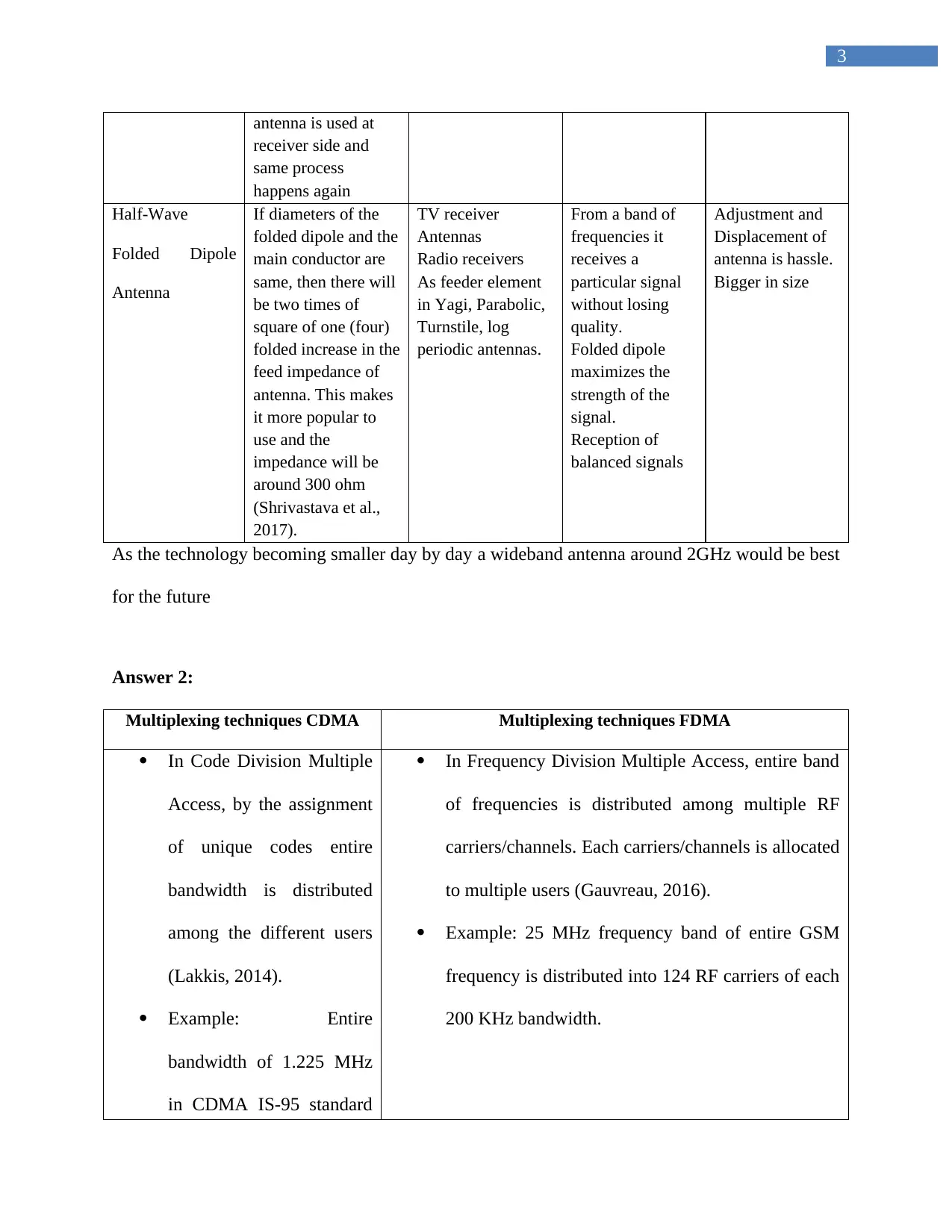
3
antenna is used at
receiver side and
same process
happens again
Half-Wave
Folded Dipole
Antenna
If diameters of the
folded dipole and the
main conductor are
same, then there will
be two times of
square of one (four)
folded increase in the
feed impedance of
antenna. This makes
it more popular to
use and the
impedance will be
around 300 ohm
(Shrivastava et al.,
2017).
TV receiver
Antennas
Radio receivers
As feeder element
in Yagi, Parabolic,
Turnstile, log
periodic antennas.
From a band of
frequencies it
receives a
particular signal
without losing
quality.
Folded dipole
maximizes the
strength of the
signal.
Reception of
balanced signals
Adjustment and
Displacement of
antenna is hassle.
Bigger in size
As the technology becoming smaller day by day a wideband antenna around 2GHz would be best
for the future
Answer 2:
Multiplexing techniques CDMA Multiplexing techniques FDMA
In Code Division Multiple
Access, by the assignment
of unique codes entire
bandwidth is distributed
among the different users
(Lakkis, 2014).
Example: Entire
bandwidth of 1.225 MHz
in CDMA IS-95 standard
In Frequency Division Multiple Access, entire band
of frequencies is distributed among multiple RF
carriers/channels. Each carriers/channels is allocated
to multiple users (Gauvreau, 2016).
Example: 25 MHz frequency band of entire GSM
frequency is distributed into 124 RF carriers of each
200 KHz bandwidth.
antenna is used at
receiver side and
same process
happens again
Half-Wave
Folded Dipole
Antenna
If diameters of the
folded dipole and the
main conductor are
same, then there will
be two times of
square of one (four)
folded increase in the
feed impedance of
antenna. This makes
it more popular to
use and the
impedance will be
around 300 ohm
(Shrivastava et al.,
2017).
TV receiver
Antennas
Radio receivers
As feeder element
in Yagi, Parabolic,
Turnstile, log
periodic antennas.
From a band of
frequencies it
receives a
particular signal
without losing
quality.
Folded dipole
maximizes the
strength of the
signal.
Reception of
balanced signals
Adjustment and
Displacement of
antenna is hassle.
Bigger in size
As the technology becoming smaller day by day a wideband antenna around 2GHz would be best
for the future
Answer 2:
Multiplexing techniques CDMA Multiplexing techniques FDMA
In Code Division Multiple
Access, by the assignment
of unique codes entire
bandwidth is distributed
among the different users
(Lakkis, 2014).
Example: Entire
bandwidth of 1.225 MHz
in CDMA IS-95 standard
In Frequency Division Multiple Access, entire band
of frequencies is distributed among multiple RF
carriers/channels. Each carriers/channels is allocated
to multiple users (Gauvreau, 2016).
Example: 25 MHz frequency band of entire GSM
frequency is distributed into 124 RF carriers of each
200 KHz bandwidth.
Paraphrase This Document
Need a fresh take? Get an instant paraphrase of this document with our AI Paraphraser
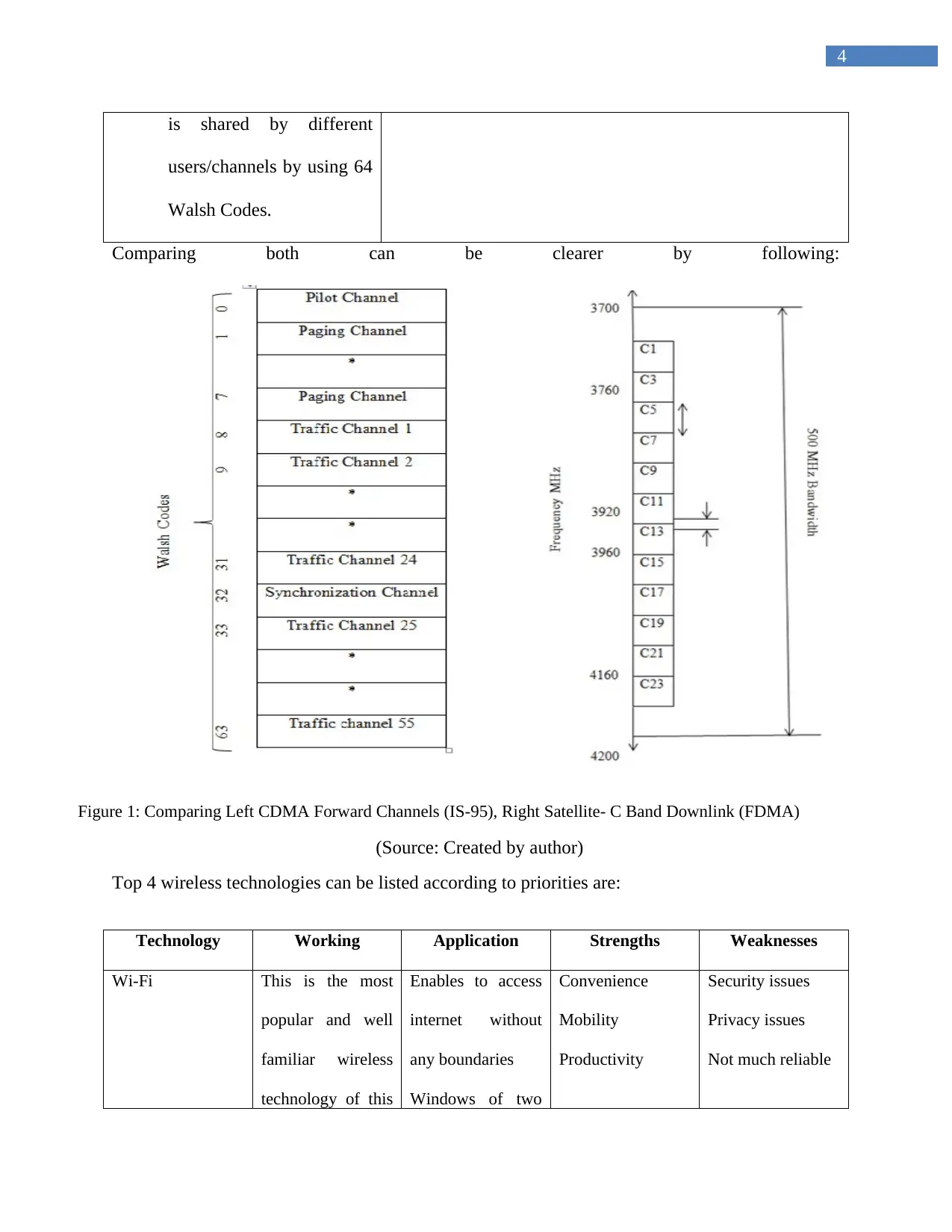
4
is shared by different
users/channels by using 64
Walsh Codes.
Comparing both can be clearer by following:
Answer 3:
Top 4 wireless technologies can be listed according to priorities are:
Technology Working Application Strengths Weaknesses
Wi-Fi This is the most
popular and well
familiar wireless
technology of this
Enables to access
internet without
any boundaries
Windows of two
Convenience
Mobility
Productivity
Security issues
Privacy issues
Not much reliable
Figure 1: Comparing Left CDMA Forward Channels (IS-95), Right Satellite- C Band Downlink (FDMA)
(Source: Created by author)
is shared by different
users/channels by using 64
Walsh Codes.
Comparing both can be clearer by following:
Answer 3:
Top 4 wireless technologies can be listed according to priorities are:
Technology Working Application Strengths Weaknesses
Wi-Fi This is the most
popular and well
familiar wireless
technology of this
Enables to access
internet without
any boundaries
Windows of two
Convenience
Mobility
Productivity
Security issues
Privacy issues
Not much reliable
Figure 1: Comparing Left CDMA Forward Channels (IS-95), Right Satellite- C Band Downlink (FDMA)
(Source: Created by author)
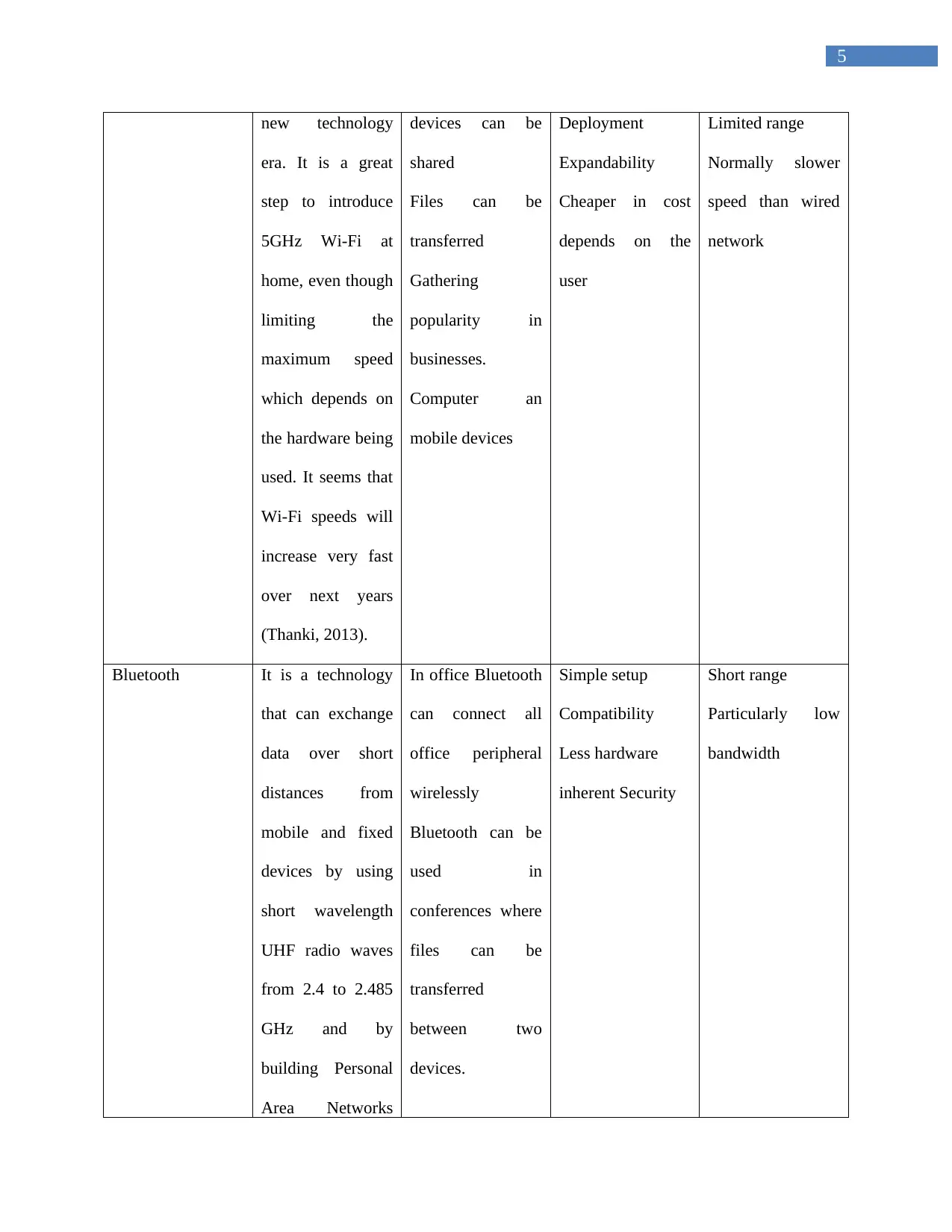
5
new technology
era. It is a great
step to introduce
5GHz Wi-Fi at
home, even though
limiting the
maximum speed
which depends on
the hardware being
used. It seems that
Wi-Fi speeds will
increase very fast
over next years
(Thanki, 2013).
devices can be
shared
Files can be
transferred
Gathering
popularity in
businesses.
Computer an
mobile devices
Deployment
Expandability
Cheaper in cost
depends on the
user
Limited range
Normally slower
speed than wired
network
Bluetooth It is a technology
that can exchange
data over short
distances from
mobile and fixed
devices by using
short wavelength
UHF radio waves
from 2.4 to 2.485
GHz and by
building Personal
Area Networks
In office Bluetooth
can connect all
office peripheral
wirelessly
Bluetooth can be
used in
conferences where
files can be
transferred
between two
devices.
Simple setup
Compatibility
Less hardware
inherent Security
Short range
Particularly low
bandwidth
new technology
era. It is a great
step to introduce
5GHz Wi-Fi at
home, even though
limiting the
maximum speed
which depends on
the hardware being
used. It seems that
Wi-Fi speeds will
increase very fast
over next years
(Thanki, 2013).
devices can be
shared
Files can be
transferred
Gathering
popularity in
businesses.
Computer an
mobile devices
Deployment
Expandability
Cheaper in cost
depends on the
user
Limited range
Normally slower
speed than wired
network
Bluetooth It is a technology
that can exchange
data over short
distances from
mobile and fixed
devices by using
short wavelength
UHF radio waves
from 2.4 to 2.485
GHz and by
building Personal
Area Networks
In office Bluetooth
can connect all
office peripheral
wirelessly
Bluetooth can be
used in
conferences where
files can be
transferred
between two
devices.
Simple setup
Compatibility
Less hardware
inherent Security
Short range
Particularly low
bandwidth
⊘ This is a preview!⊘
Do you want full access?
Subscribe today to unlock all pages.

Trusted by 1+ million students worldwide
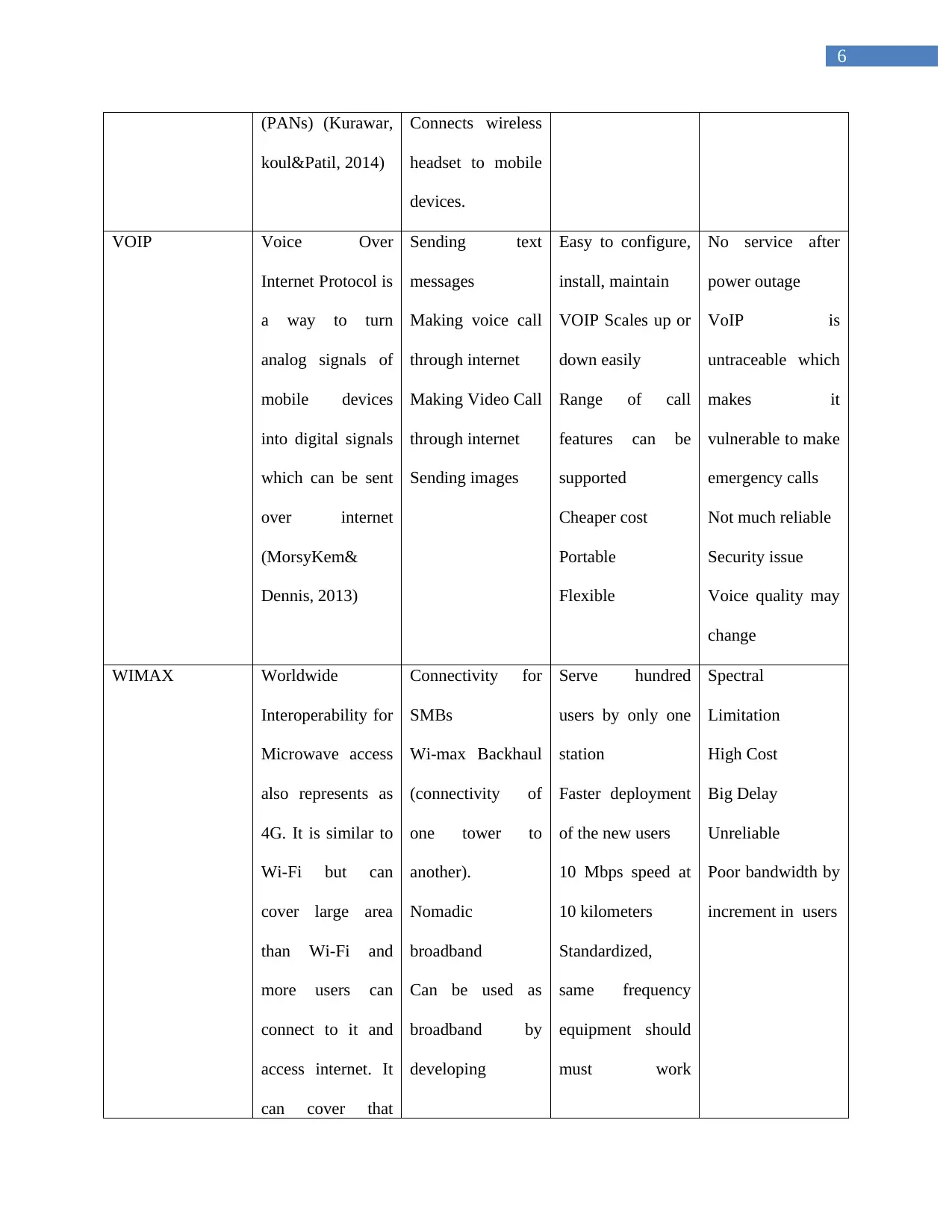
6
(PANs) (Kurawar,
koul&Patil, 2014)
Connects wireless
headset to mobile
devices.
VOIP Voice Over
Internet Protocol is
a way to turn
analog signals of
mobile devices
into digital signals
which can be sent
over internet
(MorsyKem&
Dennis, 2013)
Sending text
messages
Making voice call
through internet
Making Video Call
through internet
Sending images
Easy to configure,
install, maintain
VOIP Scales up or
down easily
Range of call
features can be
supported
Cheaper cost
Portable
Flexible
No service after
power outage
VoIP is
untraceable which
makes it
vulnerable to make
emergency calls
Not much reliable
Security issue
Voice quality may
change
WIMAX Worldwide
Interoperability for
Microwave access
also represents as
4G. It is similar to
Wi-Fi but can
cover large area
than Wi-Fi and
more users can
connect to it and
access internet. It
can cover that
Connectivity for
SMBs
Wi-max Backhaul
(connectivity of
one tower to
another).
Nomadic
broadband
Can be used as
broadband by
developing
Serve hundred
users by only one
station
Faster deployment
of the new users
10 Mbps speed at
10 kilometers
Standardized,
same frequency
equipment should
must work
Spectral
Limitation
High Cost
Big Delay
Unreliable
Poor bandwidth by
increment in users
(PANs) (Kurawar,
koul&Patil, 2014)
Connects wireless
headset to mobile
devices.
VOIP Voice Over
Internet Protocol is
a way to turn
analog signals of
mobile devices
into digital signals
which can be sent
over internet
(MorsyKem&
Dennis, 2013)
Sending text
messages
Making voice call
through internet
Making Video Call
through internet
Sending images
Easy to configure,
install, maintain
VOIP Scales up or
down easily
Range of call
features can be
supported
Cheaper cost
Portable
Flexible
No service after
power outage
VoIP is
untraceable which
makes it
vulnerable to make
emergency calls
Not much reliable
Security issue
Voice quality may
change
WIMAX Worldwide
Interoperability for
Microwave access
also represents as
4G. It is similar to
Wi-Fi but can
cover large area
than Wi-Fi and
more users can
connect to it and
access internet. It
can cover that
Connectivity for
SMBs
Wi-max Backhaul
(connectivity of
one tower to
another).
Nomadic
broadband
Can be used as
broadband by
developing
Serve hundred
users by only one
station
Faster deployment
of the new users
10 Mbps speed at
10 kilometers
Standardized,
same frequency
equipment should
must work
Spectral
Limitation
High Cost
Big Delay
Unreliable
Poor bandwidth by
increment in users
Paraphrase This Document
Need a fresh take? Get an instant paraphrase of this document with our AI Paraphraser
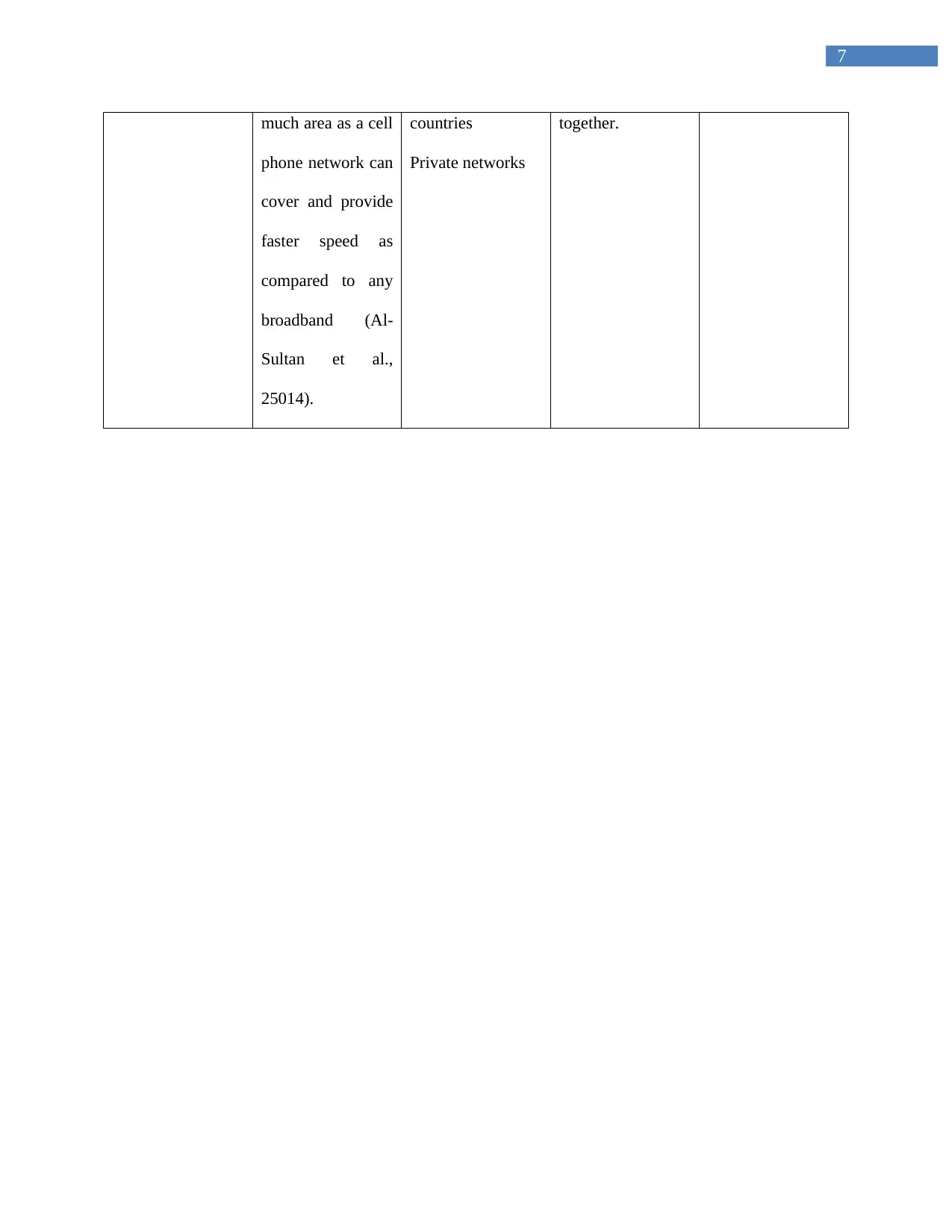
7
much area as a cell
phone network can
cover and provide
faster speed as
compared to any
broadband (Al-
Sultan et al.,
25014).
countries
Private networks
together.
much area as a cell
phone network can
cover and provide
faster speed as
compared to any
broadband (Al-
Sultan et al.,
25014).
countries
Private networks
together.
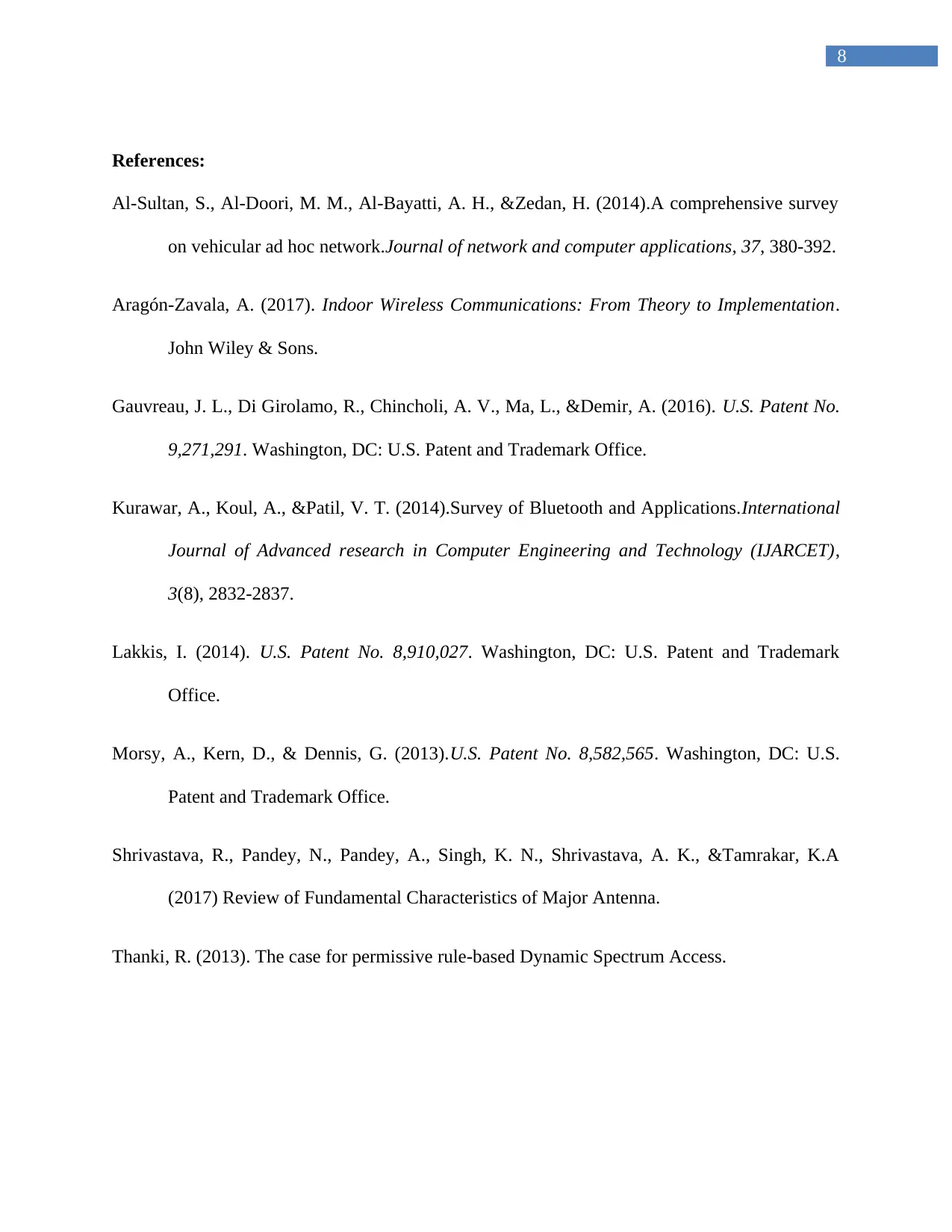
8
References:
Al-Sultan, S., Al-Doori, M. M., Al-Bayatti, A. H., &Zedan, H. (2014).A comprehensive survey
on vehicular ad hoc network.Journal of network and computer applications, 37, 380-392.
Aragón-Zavala, A. (2017). Indoor Wireless Communications: From Theory to Implementation.
John Wiley & Sons.
Gauvreau, J. L., Di Girolamo, R., Chincholi, A. V., Ma, L., &Demir, A. (2016). U.S. Patent No.
9,271,291. Washington, DC: U.S. Patent and Trademark Office.
Kurawar, A., Koul, A., &Patil, V. T. (2014).Survey of Bluetooth and Applications.International
Journal of Advanced research in Computer Engineering and Technology (IJARCET),
3(8), 2832-2837.
Lakkis, I. (2014). U.S. Patent No. 8,910,027. Washington, DC: U.S. Patent and Trademark
Office.
Morsy, A., Kern, D., & Dennis, G. (2013).U.S. Patent No. 8,582,565. Washington, DC: U.S.
Patent and Trademark Office.
Shrivastava, R., Pandey, N., Pandey, A., Singh, K. N., Shrivastava, A. K., &Tamrakar, K.A
(2017) Review of Fundamental Characteristics of Major Antenna.
Thanki, R. (2013). The case for permissive rule-based Dynamic Spectrum Access.
References:
Al-Sultan, S., Al-Doori, M. M., Al-Bayatti, A. H., &Zedan, H. (2014).A comprehensive survey
on vehicular ad hoc network.Journal of network and computer applications, 37, 380-392.
Aragón-Zavala, A. (2017). Indoor Wireless Communications: From Theory to Implementation.
John Wiley & Sons.
Gauvreau, J. L., Di Girolamo, R., Chincholi, A. V., Ma, L., &Demir, A. (2016). U.S. Patent No.
9,271,291. Washington, DC: U.S. Patent and Trademark Office.
Kurawar, A., Koul, A., &Patil, V. T. (2014).Survey of Bluetooth and Applications.International
Journal of Advanced research in Computer Engineering and Technology (IJARCET),
3(8), 2832-2837.
Lakkis, I. (2014). U.S. Patent No. 8,910,027. Washington, DC: U.S. Patent and Trademark
Office.
Morsy, A., Kern, D., & Dennis, G. (2013).U.S. Patent No. 8,582,565. Washington, DC: U.S.
Patent and Trademark Office.
Shrivastava, R., Pandey, N., Pandey, A., Singh, K. N., Shrivastava, A. K., &Tamrakar, K.A
(2017) Review of Fundamental Characteristics of Major Antenna.
Thanki, R. (2013). The case for permissive rule-based Dynamic Spectrum Access.
⊘ This is a preview!⊘
Do you want full access?
Subscribe today to unlock all pages.

Trusted by 1+ million students worldwide
1 out of 9
Related Documents
Your All-in-One AI-Powered Toolkit for Academic Success.
+13062052269
info@desklib.com
Available 24*7 on WhatsApp / Email
![[object Object]](/_next/static/media/star-bottom.7253800d.svg)
Unlock your academic potential
Copyright © 2020–2025 A2Z Services. All Rights Reserved. Developed and managed by ZUCOL.





